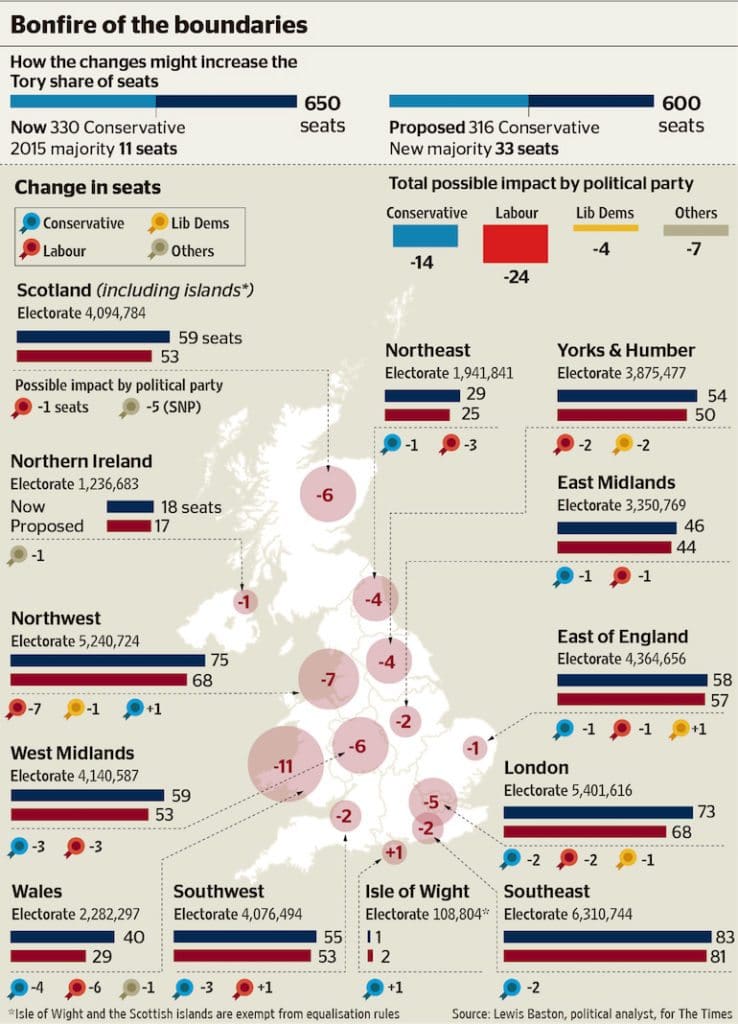Two days after winning the 2015 general election, senior Conservatives said their top priority would be redrawing the nation’s constituency boundaries. Ten months on, a boundary review has been launched – and it could lock Labour out of power for a generation or more.
Boundary reviews are nothing new. Constituency boundaries have been regularly reviewed and updated as the country’s demographics have changed. But this government’s review is “the biggest shake-up of our political map in anyone’s lifetime,” according to the BBC. It will see the number of UK MPs slashed from 650 to 600 and a radical redrawing of our constituencies – all in good time for the next general election.
On the face of it, the Tories’ rationale for changing the boundaries so radically is perfectly reasonable – they want to “cut the cost of politics and make votes of more equal value”. In 2011, the coalition government introduced rules to this effect, obliging the UK’s independent Boundary Commissions to reduce the number of MPs to 600 and ensure each constituency contains roughly the same numbers of voters.
In late February, the UK’s four Boundary Commissions began their first review since those rules were introduced. They also announced the figures they will use to redraw Britain’s boundaries as well as the number of MPs each region will lose. While it has been clear for some time that the Tories would benefit most from any boundary changes made on these terms, it is only now that a picture of Britain’s new political electoral map is starting to emerge.
Political analyst Lewis Baston has carried out an analysis for The Times, based on the Boundary Commissions’ latest data:

Of the 50 seats due to be axed, Baston thinks it likely that Labour will lose 24 seats while the Conservatives will lose just 14. The SNP will lose 5, the Lib Dems 4, Plaid Cymru 1 and the single seat loss in Northern Ireland, while difficult to compute, will possibly be the SDLP.
In percentage terms, this means that the Tories will lose around four percent of their seats to the SNP’s nine percent, Labour’s 10%, Plaid Cymru’s 33% and the Lib Dems’ an eye-watering 50%.
Had the 2015 election been carried out with these new boundaries in place, Baston suggests, the Tory majority would be triple its current size, leaping from 11 to 33 seats. It is hard to disagree with the BBC’s Shaun Ley when he writes:
This boundary review – conducted entirely impartially but using rules determined by Parliament – could finish off the Labour Party’s chances of ever returning to government.
This is partly down to the maths of making sure each constituency contains the same number of voters. To ensure that, many small, urban constituencies (which are more likely to vote Labour) will have to be merged, losing Labour seats. Others will be expanded to draw in suburban and rural voters from surrounding areas (more likely to vote Conservative), handing Labour seats to the Conservatives or making them more marginal.
This might seem reasonable. If we want votes to be more or less equally counted within the constraints of our current electoral system, it makes sense that constituencies should be the same size.
But there’s a catch. Constituencies will be the same size not in terms of the number of people who live in them, but in terms of the number of registered voters. And the number of voters will be based on the number of registered voters on 1 December 2015 – just after the Tories deleted hundreds of thousands of names from the electoral register by rushing through changes to the voting rules, orchestrating what Hope not Hate calls “the biggest single act of electoral disenfranchisement in our history”.
And the people it deleted are disproportionately from deprived, urban and university areas – ie they are more likely to be Labour voters. This means the UK’s new boundaries will be based on data that vastly underestimates the number of Labour voters.
As Hope Not Hate’s John Page asks:
Why on earth would the government want to do a boundary review based on undercounting of voters? We will be stuck for a generation with the number of votes at 1st December 2015 when everyone knows that’s under-representation.
Given the Tories’ systematic dismantling of our democracy to date, the answer is almost certainly that it will help to lock them into power in 2020 and beyond. If we want to avoid permanent Tory rule now, it seems, we have to hope their political opponents will unite against them in a progressive alliance. Luckily for us, that’s exactly what several UK parties are discussing right now.
Get involved!
Keep an eye out for the boundary review consultation, which will begin in September, and make sure you have your say.
Support Hope Not Hate.
Join the Electoral Reform Society.
Support The Canary so we can keep holding the government to account.
Featured image adapted from DfID/Flickr.

















